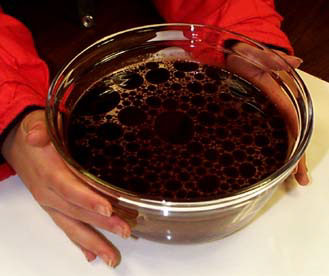|
Oil Floats and Spreads
 |
|
Picture of Step 3
|
- Get a large, clear glass bowl and some vegetable oil.
If you'd like, you can mix a little cocoa powder into the vegetable oil to make it show up better and look more like crude oil.
- Fill the bowl with water to an inch or two below the rim.
Place it on a table, and have everyone crowd around it.
- Pour a little oil on the water.
- Now, watch what happens.
The oil, even a little drop, will spread out over the water surface and break up into many little blobs. This will happen very quickly.
 |
|
Picture of Step 4
|
All oils are not the same. Different oils, whether diesel for a truck or heating oil for a house or oil for an engine, all spread out at different rates.
Also, note that the oil floats. This seems a simple observation but it is very important. Since you have a glass bowl, you can see two layers, or phases: oil and water, which do not mix. You have probably seen this before in some bottles of salad dressing. In the bottle of dressing, just like in the bowl, the oil stays on the top and the water stays on the bottom.
When oil is spilled onto the ocean, because it stays on the top of the water in this same way, it can be pushed by the wind in whatever direction the wind is going. Wind, along with currents and tides, are the three main factors that affect the transportation of oil during an oil spill. We look at all three of these to predict where the oil might go and what it might hit.
Other pages in this series
|
- Cleaning Oiled Feathers You can use your bowl of water and oil in an experiment testing how to clean oiled feathers
|
|


